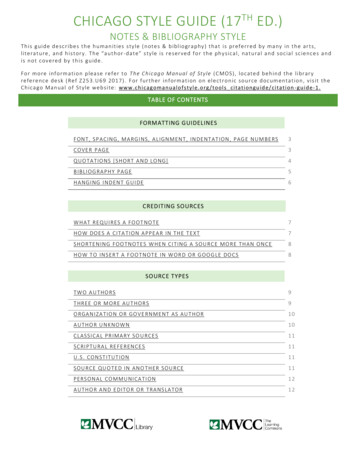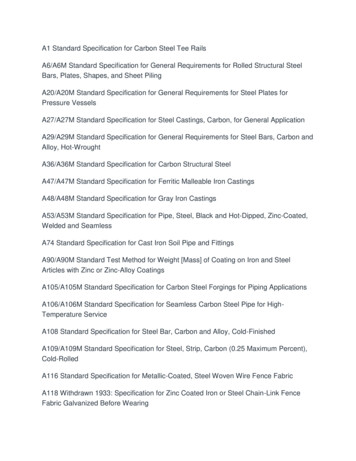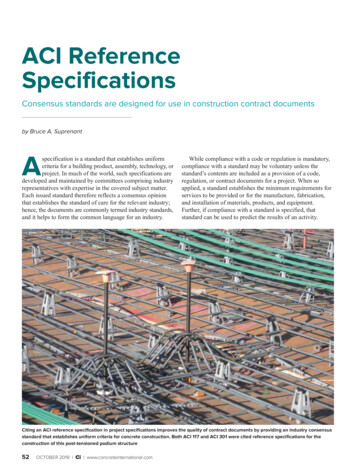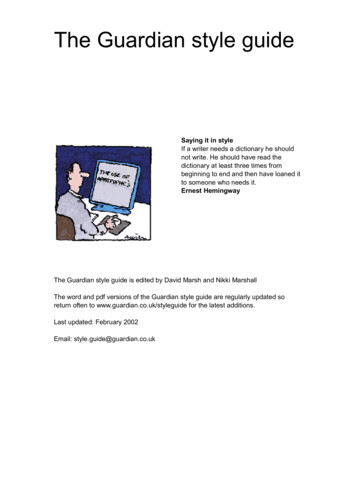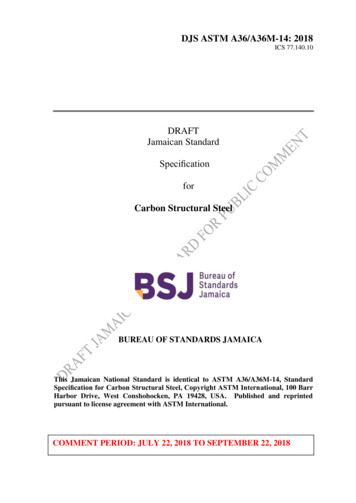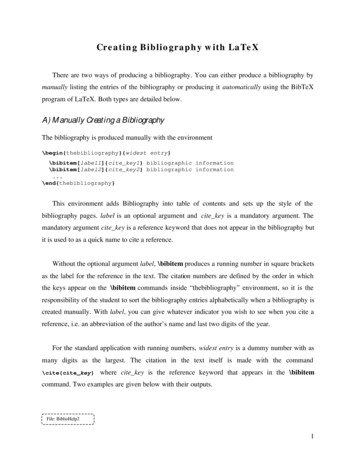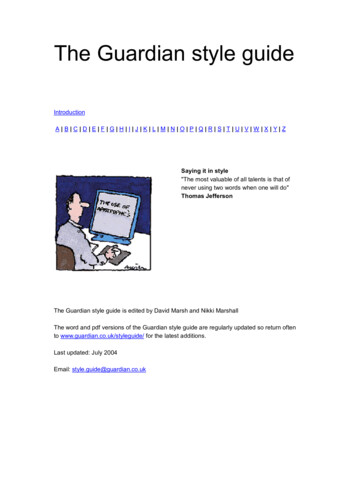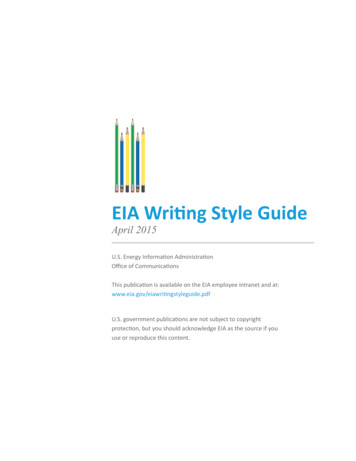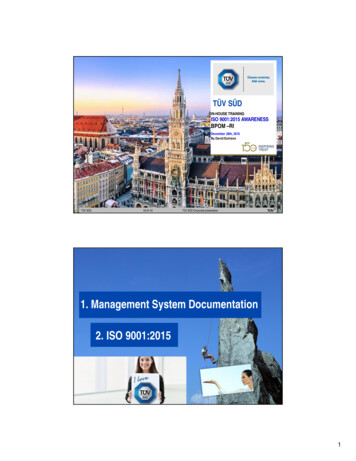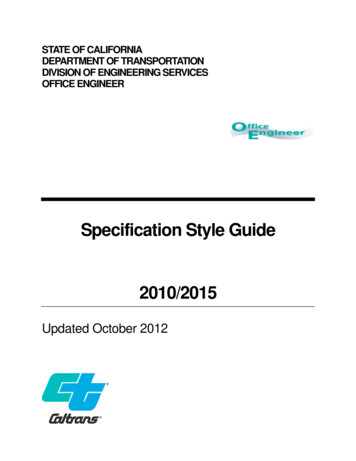
Transcription
STATE OF CALIFORNIADEPARTMENT OF TRANSPORTATIONDIVISION OF ENGINEERING SERVICESOFFICE ENGINEERSpecification Style Guide2010/2015Updated October 2012
CONTENTS1 GENERAL .12 REFERENCE FOR GRAMMAR, USAGE, CAPITALIZATION, AND PUNCTUATION .13 FEDERAL REGISTER'S WRITING GUIDE .14 BREVITY .55 INDUSTRY STANDARD .56 EXPRESSIONS .67 TERMS FOR ALTERATION AND REPAIR OF HIGHWAY FACILITIES .88 SPECIFICATION DUPLICATION .89 COMMON CLAUSES AND PHRASES .910 PAYMENT CLAUSES . 1011 REFERENCES . 1212 LAW CITATION . 1313 PUNCTUATION AND TYPOGRAPHY . 1414 ABBREVIATIONS. 1615 DEFINITIONS . 1616 SYMBOLS . 1617 NUMBERS . 1718 DIMENSIONS . 1719 EQUATIONS . 1720 CHEMICALS . 1821 FRACTIONS . 1822 MEASUREMENTS . 1823 PERCENTAGES . 1924 ADDRESSES . 1925 PHONE NUMBERS . 1926 RANGES . 1927 SLOPES . 1928 TOLERANCES . 1929 LISTS . 1930 TABLES . 2031 RSSs AND SSPs . 2232 ORGANIZATION . 2733 FORMAT . 29BIBLIOGRAPHY . 30APPENDIX 1 SECTION CONTENTS FOR NEW OR COMPLETELY REORGANIZED SECTIONS OF THESTANDARD SPECIFICATIONS AND SSPS. . 31APPENDIX 2 SPECIFICATION TEMPLATE GUIDE FOR A LEVEL-2 SSP . 32APPENDIX 3 SPECIFICATION TEMPLATE GUIDE FOR A LEVEL-2 RSS . 35APPENDIX 4 SECTION 99 SPECIFICATIONS . 44APPENDIX 5 2010 BACKGROUND . 46APPENDIX 6 RESERVED. 49APPENDIX 7 CHECKLIST . 50
CHANGE DIGESTChanges to the Specification Style Guide are summarized in the following table. Digest entries will be deletedafter 6 months.VersionApril 2012Section33July 2012Appendix 4101419243031October 201233Appendix 3Cover123689101316222629303132Appendix 1Appendix 2Appendix 3Appendix 6Appendix 7ChangeCorrected location of template guides.Added guidance for use of the RSS template guide.Added document saving view, size, and styles shown.Corrected name of macro.Replaced the full payment clause with a non–full payment clause. Added anon–transfer pay clause.Added an exception for "number."Changed the guidance on using Microsoft Word's Equation Editor from"Avoid" to "Do not use."Clarified the style of an address.Added pictures to show the space above a table.Corrected definitions of individual and combined SSPs. Fixed spacing in SSP14-6.02 example. Added list and table examples. Added guidance for listinstructions.Added guidance on a header and footer setting.Added an explanation for the use of the examples.Added "/2015"Added an explanation of guidance for the 2015 standards.Added an interpretation of a reference to the Standard Specifications.Changed reference for index entries to 2010 Standard Specifications.Expounded upon rule for use of singular nouns.Changed preferred expressions to mandatory for the 2015 specifications.Clarified guidance on submittals.Moved payment clauses from section 9 to section 10.Added guidance on measurement of quantities. Added examples. Movedfootnotes to table cells. Added payment clauses from section 9.Combined guidance on hyphens and spaces. See change for section 22.Added guidance on italics. Added guidance on parentheses for explanatorytags in tables.Added guidance for the use of en dashes in paragraph instructions.Replaced the guidance on spacing and hyphenation for numbers withabbreviations with examples and moved the guidance to section 13. Replacedthe guidance for numbers and unabbreviated measurement units withexamples and moved the guidance to section 13.Added a reference to section 16.Expounded upon list guidance. Reorganized section.Added guidance on automatic resizing.Added guidance on placement of units, abbreviations, and other modifiers.Deleted guidance for list instructions that were added in July 2012. Thisguidance has been moved to the SP template.Changed guidance for references to an RSS.Changed guidance for adding text to an existing section.Added guidance on including a section heading in the StandardSpecifications. Noted 2010 for applicability of using outlines. Replacedguidance with references to appendix 1.Updated to reflect some of the changes in the 2009 version of SectionFormat.Updated SSP template guide to show table note with NOTE in uppercase.Updated RSS template guide to show table note with NOTE in uppercase.Added a note for the use of the Add a paragraph example.Added a reserved section for the 2010 and 2015 outlines.Added a checklist.
1 GENERALThis guide provides instructions for specification writers contributing to the Department of Transportation'sconstruction specifications.Section 1 of this guide applies to all specification sections. Sections 2 through 33 and all appendixes exceptappendix 4 of this guide apply to all specification sections except section 99. Appendix 4 applies to section 99specifications.This guide is based on information from several sources, including the Federal Register's writing guidelines,The Chicago Manual of Style (Chicago), Construction Specifications Institute (CSI), AASHTO GuideSpecifications for Highway Construction, and the highway construction specifications of other states. Thesesources may be shown in parenthesis for your information.The examples in this guide are models for style, not actual specifications.Guidance shaded in Gray-25% with a 2010/2015 superscript must be used for 2015 specifications. It may be2010/2015used for 2010 specifications. (Guidance)Guidance shaded in Gray-25% with a 2015 superscript applies to 2015 specifications only. It must not be2015used for 2010 specifications. (Guidance )Guidance with a 2010 superscript applies to 2010 specifications only. This guidance will be deleted when the2010development of 2010 specifications ceases.(Guidance )Interpret a reference to the Standard Specifications as the Standard Specifications as revised by any revisedstandard specification.Interpret each rule as if followed by unless context and common sense dictate otherwise. Do not follow a ruleif clarity is reduced.2 REFERENCE FOR GRAMMAR, USAGE, CAPITALIZATION, AND PUNCTUATIONFor guidance not covered in this guide, follow the guidance provided in the 15th edition of Chicago forgrammar, usage, capitalization, and punctuation. Chicago's Web site has answers to many grammar, usage,capitalization, and punctuation questions. The Specification Style Guide provides rules:1. From Chicago that are not used in everyday writing.2. Not covered in Chicago.3. Contrary to the rules in Chicago (only a few of these). For the contrary rules, follow the rules in this guide.Where the Chicago allows optional styles, choose the traditional style.Exception: For index entries, use the format of the 2010 Standard Specifications.3 FEDERAL REGISTER'S WRITING GUIDEFollow the principles in the Federal Register's Principles of Clear Writing, duplicated in part in this section. Foradditional explanations, go legal-docs/clear-writing.htmlBracketed text is text not in the Federal Register's Principles of Clear Writing. The following rule numberscorrespond with the rule numbers in the Federal Register's guide.1. Write in the active voice.The passive voice is appropriate when the actor is unknown, unimportant, or obvious.2. Use action verbs.1
Don't saySayis applicable tomake paymentgive recognition tois concerned withapplies topayrecognizeconcerns3. Use must instead of shall.shallwillmustshouldmayimposes an obligation to act, but may be confused with prediction of future actionpredicts future actionimposes obligation, indicates a necessity to actinfers obligation, but not absolute necessityindicates discretion to act4. Be direct.Talk directly to your readers. [In the Department's specifications, talk to the Contractor.] Use the imperativemood. [Also, use you and your.]This style results in [specifications] that are shorter, crisper, and easier to understand.5. Use the present tense.A [specification] speaks as of the time you apply it, not as of the time you draft it.6. Write positively.If you can accurately express an idea either positively or negatively, express it positively. It's better to expresseven a negative in positive form.did not comply withDon't sayfailed to comply withSayviolated[Example: If you violate Pub Cont Code § 4100 et seq., the Department may exercise the remedies providedunder Pub Cont Code § 4110.]7. Avoid use of exceptions.If possible, state a rule or category directly rather than describing that rule or category by stating itsexceptions.Don't saySayAll persons except those 18 years or older must . . .Each person under 18 years of age must . . .[Use section section no. applies to x or Requirement description applies to x or introduce arequirement with For x .]However, you may use an exception if it avoids a long and cumbersome list or elaborate description.[If a specification has exceptions, do not use general phrases such as except as otherwise specified or exceptas otherwise shown. Instead, specify the particular items to which the specification does not apply.]8. Avoid split infinitives.The split infinitive offends many readers, so avoid it if you can.2
Don't sayBe sure to promptly reply to the invitation.SayBe sure to reply promptly to the invitation.orBe sure to reply to the invitation promptly.9. Use the singular noun rather than the plural noun.To the extent your meaning allows, use a singular noun instead of a plural noun. You will avoid the problem ofwhether the rule applies separately to each member of a class or jointly to the class as a whole. [This doesnot mean that you should drop all s's. In complying with this guideline, sentences must still be grammaticallycorrect. The example below demonstrates the use of this guideline.]Don't sayThe guard will issue security badges to theemployees who work in Building D and Building E.SayThe guard will issue a security badge to eachemployee who works in Building D and eachemployee who works in Building E.[Exceptions:1. Use plural nouns for headings and titles except existing ones.2. If an existing bid item description is plural, use the plural form.]10. Be consistent.Don't use different words to denote the same thing. Don't use the same word to denote different things.Don't saySayEach motor vehicle owner must register his or her carwith the Automobile Division of the Metropolitan PoliceDepartment.Each automobile owner must register his or herautomobile with the Automobile Division of theMetropolitan Police Department.The tank had a 200-gallon tank for fuel.The tank had a 200-gallon fuel container.11. Use parallel structure.Arrange sentences so that parallel ideas look parallel. This is important when you use a list.[The following example is from the Federal Register's writing guide except that the format of the lists has beenchanged to comply with the format described in this guide.]Nonparallel construction:The duties of the Executive Secretary of the Administrative Committee are:1. To take minutes of all the meetings2. The Executive Secretary answers all the correspondence3. Writing of monthly reportsParallel construction:The duties of the Executive Secretary of the Administrative Committee are to:1. Take minutes of all the meetings2. Answer all the correspondence3. Write the monthly reports12. Prefer simple words.[See "Preferred Expressions" of this guide and plain language Web sites such as www.plainlanguage.gov andwww.plainlanguagenetwork.org.]3
13. Omit needless words.Don't saybecause of the fact thatfor the period of[highway right-of-way][including, but not limited to]Saybecausefor[highway][including]14. Avoid redundancies.Don't use word pairs, if the words have the same effect or where the meaning of one included the other.Examples: Word pairs to avoidany and allauthorize and directcease and desisteach and everyfull and completeorder and directmeans and includesnecessary and desirable15. Use concrete words.Abstract words can be vague and open to different interpretations. [Use] simple, concrete words. [Be specific.]Don't sayIf you rcraft16. Don't use words that antagonize.[Not applicable to specification writing.]17. Avoid noun sandwiches.Administrative writing uses too many noun clusters –- groups of nouns "sandwiched" together. Avoid theseconfusing constructions by using more prepositions.Don't sayUnderground mine worker safetyprotection procedures developmentSayDevelopment of undergroundprocedures for the protectionof the safety of mine workers[Or][Development of safetyprocedures for protectingworkers underground.]Which meaning is intended becomes clearer when this four-word sandwich is broken up.18. Don't use gender-specific terminology.[Exception: You may use gender-specific terminology if required to match industry-standard terminology orthe law.]19. Write short sentences.20. Make lists clear and logical in structure.[List by work sequence or most important to least important. If no logic, list alphabetically. Display a list of 3items in a vertical list.]21. Use short paragraphs.A writer may improve the clarity of a [specification] by using short, compact paragraphs. Each paragraphshould deal with a single, unified topic. Lengthy, complex, or technical discussions should be presented in aseries of related paragraphs.4
4 BREVITYBe as brief as possible without reducing clarity.Avoid prepositions. But do not eliminate prepositions if noun sandwiches or nonparallel clauses or phrasesare created as a result.Don't sayauthority of the Engineerdrawings for falseworkSayEngineer's authorityfalsework drawingsUse elliptical clauses.Don't sayFor excusable delays that are not caused byweather, the Department pays your added costs.If the Engineer determines that a claim is withoutmerit, you may pursue the administrative claimprocedure . . .SayFor excusable delays not caused by weather,the Department pays your added costs.If the Engineer determines a claim is withoutmerit, you may pursue the administrative claimprocedure . . .Avoid unnecessary qualifiers. Examples:actualall (except to differentiate between partial and whole quantities)any (except to specify a choice)existing (with remove, reconstruct, salvage, abandon, or obliterate)Avoid respective and respectively.Don't sayForms are listed under the names of theirrespective sections.The hat and the scarf must be blue and green,respectively.SayForms are listed under the names of theircorresponding sections.The hat must be blue. The scarf must be green.5 INDUSTRY STANDARDUse terms in prevalent use by other states and the construction industry. Do not use terms unique to theDepartment. Use of a unique term requires concurrence by the specification owner, Construction, and Legal.5
6 EXPRESSIONSUse the following mandatory expressions for contractual integrity:Mandatory ExpressionsUseDo not use synonymsaccept (for an agreement to receive something asapprove, authorize, or certify (for an agreement tosatisfactory)receive something as satisfactory)approve (for COs and change order work bills)accept, authorize, or certify (for COs and changeorder work bills)authorize (for a sanctioning from the Engineer)accept, approve, or certify (for a sanctioning from theEngineer)activityoperationallowpermitassign (as an action of the Contractor)authorizedesignatecomply withadhere tofollowmeetdescribed in (to refer to the specifications and theindicated inplans; to refer to the Contract)provided in (to refer to laws or PLACs)shown in (to refer to info in a table)shown on (to refer to drawing details or notes)specified in (to refer to specifications, includingspecifications such as ASTMs)document (for general paperwork, including records)record (for general paperwork)record (as a verb; as a noun if referring to paperworkdocument (as a verb; as a noun if referring tocontaining recorded information)paperwork containing recorded information)furnish (except for furnishing work documents andgivesamples to the Engineer or Department)submit (furnishing work documents and samples tothe Engineer or Department)ajob sitesiteproject sitecontract sitebkeep (except use retain for records)retaincmaterialproductbmayis authorizedreserves the right tonotifyinformobtain (except use procure for materials)getprocuresecureupon requestat the Engineer's requestorderdirectplantfacilityproject (except use job site)jobprovisions (for laws and PLACs)conditionsspecifications (for specifications, includingrequirementsspecifications such as ASTMs)terms (for contracts not between the Department andthe tionstartbegincommencethe, this, these, that, those (Use the unless it createssuchambiguity.)trafficpublic trafficbfollowingpursuant toin conformance withundermeetingwithholdin accordance withretainaBased on definition in Means Illustrated Construction DictionaryFrom Appendix B -- Preferred Expressions of the Federal Register's Drafting Legal DocumentscFrom Means Illustrated Construction Dictionary:material: Any product or substance specified for use in the construction of a project.dReduced variation over simpler wordb6under the provisions of
Use the following preferred expressions for consistency:2010Use the following mandatory expressions for consistency:2010/20152010Preferred Expressions2010/2015Mandatory ExpressionsUseDo not use synonymsbnextsubsequent toon or after July 1prior tono later than June 30altermodifyrevisefinishterminateadequate number ofsufficient number ofexceptexcludingaforin the interest ofwith reference toahowthe manner in whichaif (except use when in reference to time and where inwhenin caseareference to location)wherein the event thatsubject toainstead ofin lieu ofconsiders (meaning deems)isdeemslimitsparametersupon (except use upon to introduce an event oroncondition)possiblefeasibletoin order toauseutilizeemployawaymannerawhenat the timeawhileduring such time asaFrom Appendix B -- Preferred Expressions of the Federal Register's Drafting Legal DocumentsbReduced variation over simpler wordadjacentaafteraafter June 30abeforeabefore July 1changecompleteendaenoughIf choosing a word not in this list, balance the following:1. Use the most basic word.2. If the most basic word has many definitions and if those definitions can cause confusion (i.e., definition isnot obvious by context), use a more precise word.3. Use industry-standard words.4. If a law is referenced, use the words in the law (only the core words, not the legalese).7
7 TERMS FOR ALTERATION AND REPAIR OF HIGHWAY FACILITIESToRemove and dispose ofRender unserviceable, in place, by doing some kind of workRemove, clean, and haul to a specified location.Remove and install or place at same station location. May be moved laterally only. Noalteration required.Remove and install or place in a new location. No alteration required.Remove and disassemble and construct again at an existing or new location. New parts oralteration may or may not be required.Raise or lower a facility to match a new grade line. Generally associated with raising framesand grates or frames and covers of facilities on resurfacing projects. May require someremoval.Includes raising or lowering of frames and covers or frames and grates of concrete or brickmanholes or circular precast concrete pipe structures by adding or subtracting raising devicesonly. Any changes to taper of manhole or steps is "remodel."A change that does not affect the basic framework or structure with only an addition orsubtraction to an appurtenant part. May require some removal. Includes raising or loweringframe and covers or frame and grate of drainage inlets by removing concrete or addingconcrete.Rebuild facility in same location. May require some removal.Remove and lay in an existing or new location. Generally used for pipes or culverts andappurtenances.NOTE: The terms and definitions in this table are from the RTL tructAdjustModifyRemodelRelay8 SPECIFICATION DUPLICATIONDo not include specifications covered by other specifications. Examples:No need foras shown on the plans; as specified in the special provisionsat the option of the ContractorAuthorization of the item needing authorization is contingent onthe item needing authorization being satisfactory to the railroadcompany involved.by the Engineer (for orders, authorizations, and requests to theContractor)to the Engineer (for submittals and requests from the Contractor)in writing (for Department approvals, authorizations, decisions,notifications, orders, and responses and for Contractorassignments, notifications, proposals, reports, requests,subcontracts, and test results)8ReasonThese are part of the Contract.From the Standard Specifications:"Where the means and methods tocomplete the work are not described inthe Contract, choose the means andmethods to complete the work."(If you specify a minimum or maximumvalue, it is the Contractor's choice to useanything greater or less. The addition ofas authorized by the Engineer creates anambiguous specification.)The contract is between the Departmentand the Contractor. Third-partycontingencies are irrelevant to theContract.Section 1 of the Standard Specificationsspecifies that orders, authorizations, andrequests to the Contractor are by theEngineerSection 1 of the Standard Specificationstells the Contractor to submit documentsand direct questions to the Engineer.Section 5 of the Standard Specificationstells the Contractor to submit action andinformational submittals to the Engineer.Section 1 of the Standard Specificationsspecifies that these items are in writing.
Driving equipment that damages piling shall not be used;provided driving does not injure the posts; and similar "do not usemethods or equipment that damage the work" clauses.Prior to closing a roadway to traffic to accommodate bridge removaloperations, the Contractor shall have all necessary workers, materials,and equipment at the site as needed to proceed with the removal work inan expeditious manner. While the roadway is closed to public traffic,work shall be pursued promptly and without interruption until theroadway is reopened to public traffic.satisfactory to the Engineer, as determined by the Engineer, andsimilar phrases and clausesspecifying what happens if the Department fails to do somethingwithin a specified timeaunless otherwise permitted by the Engineerbon approval of the Engineercif authorized by the Engineerdas ordered by the Engineereas directed by the EngineerThe Department's review and approval shall not waive anycontract requirements and shall not relieve the Contractor fromcomplying with federal, State and local laws, regulations, andrequirements. Work description includes furnishing materials.covered by Maintenance and Protectionand Payment Scope in sections 5 and 9of the Standard Specificationscovered by Public Convenience inSection 7 of the Standard Specificationscovered by Engineer's Authority insection 5 of the Standard Specificationscovered by delay definitions and delayspecifications in sections 1 and 8 of theStandard SpecificationsAmbiguous. Section 4 of the StandardSpecifications covers how changes aremade.Section 5 of the Standard Specifications:"The Department's authorization of asubmittal does not void any Contractpart."Section 5 of the Standard Specifications:"Furnish the resources, exceptDepartment-furnished materials, requiredto complete the work under theContract."a–eAvoid these altogether. They are ambiguous. Contractors will include the risk in the cost. Also see by theEngineer above.aSee allow vs. permit in section 6. If you use a similar phrase, be specific in what is otherwise allowed.bSee authorize vs. approve in section 6.cIf you use if authorized, be specific in what is authorized.dUse this only for change order work because as is too ambiguous to bid. A bidder does not know how theEngineer may order him to do something. For situations such as color or location determinations or otherfactors not involving costs to the Contractor, say, "The Engineer determines the exact color," or "TheEngineer determines the exact location," or similar.eSee order vs. direct in section 6. Also see note d above.9 COMMON CLAUSES AND PHRASESUse these common clauses and phrases.Todescribe work to be paid for by force account oraagreed pricesay one specification does not relieve the Contractorof the responsibilities in another specificationdirect the Contractor to dispose of materialsdirect the Contractor to submit a certificate ofcomplianceWrite Work description is change order work. One specification does not void otherspecification .Dispose of the material .Submit a certificate of compliance for material .9
submit documents to someone other than theEngineersubmit an informational submittal not specified as aninformational submittal in section 5bsubmit shop drawings to OSD, Documents Unitsubmit shop drawings to the Engineer signed by abregistered civil engineersubmit shop drawings signed by a registeredbmechanical or electrical engineer to the Engineersubmit shop drawings signed by a registeredmechanical or electrical to someone other than thebEngineerSubmit document to location . Notify the Engineerof the s
grammar, usage, capitalization, and punctuation. Chicago 's Web site has answers to many grammar, usage, capitalization, and punctuation questions. The. Specification Style Guide. provides rules: 1. From . Chicago. that are not used in everyday writing. 2. Not covered in . Chicago. 3. Contrary to the rul
